大学词汇学第一章
- 格式:pptx
- 大小:344.29 KB
- 文档页数:79
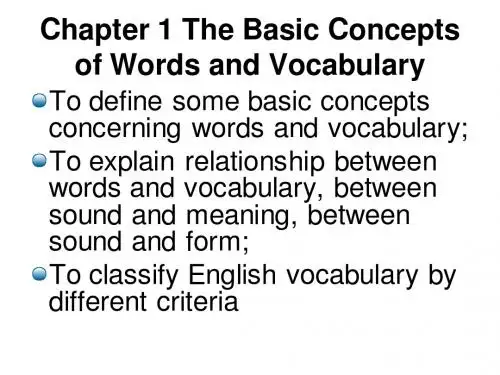
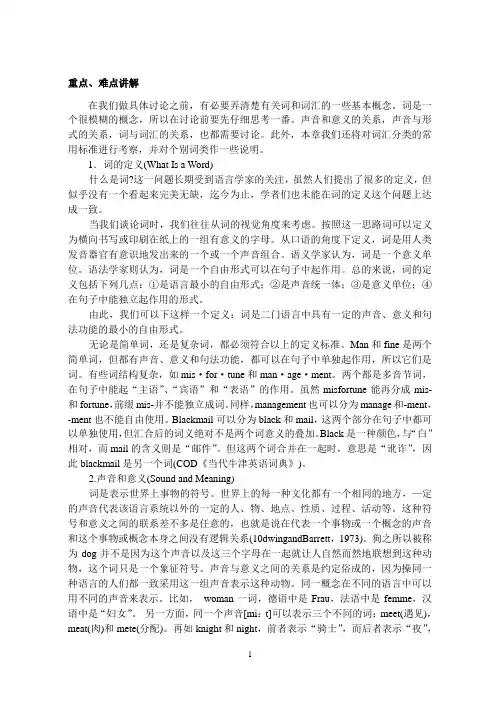
重点、难点讲解在我们做具体讨论之前,有必要弄清楚有关词和词汇的一些基本概念。
词是一个很模糊的概念,所以在讨论前要先仔细思考一番。
声音和意义的关系,声音与形式的关系,词与词汇的关系,也都需要讨论。
此外,本章我们还将对词汇分类的常用标准进行考察,并对个别词类作一些说明。
1.词的定义(What Is a Word)什么是词?这一问题长期受到语言学家的关注,虽然人们提出了很多的定义,但似乎没有一个看起来完美无缺,迄今为止,学者们也未能在词的定义这个问题上达成一致。
当我们谈论词时,我们往往从词的视觉角度来考虑。
按照这一思路词可以定义为横向书写或印刷在纸上的一组有意义的字母。
从口语的角度下定义,词是用人类发音器官有意识地发出来的一个或一个声音组合。
语义学家认为,词是一个意义单位。
语法学家则认为,词是一个自由形式可以在句子中起作用。
总的来说,词的定义包括下列几点:①是语言最小的自由形式;②是声音统一体;③是意义单位;④在句子中能独立起作用的形式。
由此,我们可以下这样一个定义:词是二门语言中具有一定的声音、意义和句法功能的最小的自由形式。
无论是简单词,还是复杂词,都必须符合以上的定义标准。
Man和fine是两个简单词,但都有声音、意义和句法功能,都可以在句子中单独起作用,所以它们是词。
有些词结构复杂,如mis·for·tune和man·age·ment。
两个都是多音节词,在句子中能起“主语”、“宾语”和“表语”的作用。
虽然misfortune能再分成mis-和fortune,前缀mis-并不能独立成词。
同样,management也可以分为manage和-ment,-ment也不能自由使用。
Blackmail可以分为black和mail,这两个部分在句子中都可以单独使用,但汇合后的词义绝对不是两个词意义的叠加。
Black是一种颜色,与“白”相对,而mail的含义则是“邮件”。
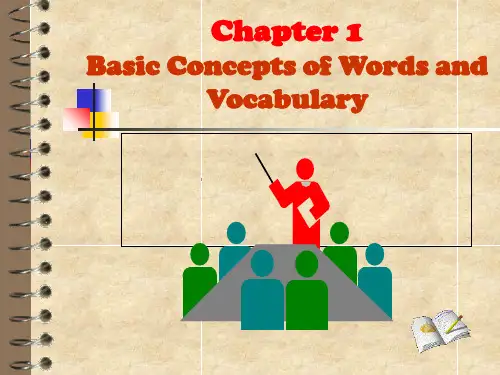
![[英语考试]高等教育自学考试英语词汇学第一章到第八章必背考点](https://uimg.taocdn.com/d2891ed3a8956bec0875e307.webp)
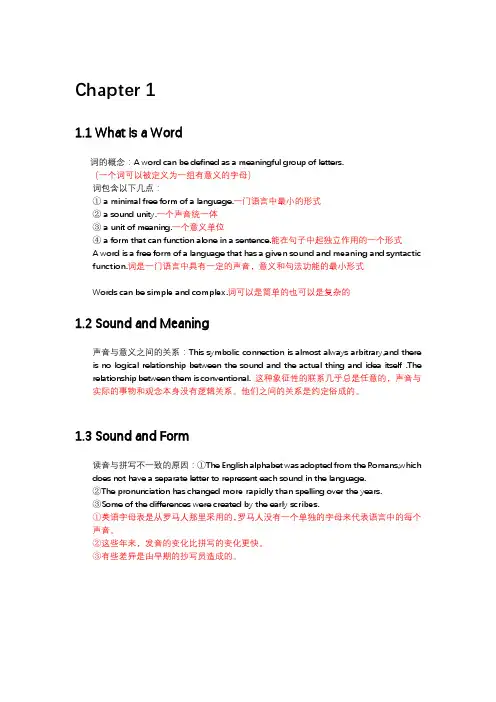
Chapter 11.1 What Is a Word词的概念:A word can be defined as a meaningful group of letters.(一个词可以被定义为一组有意义的字母)词包含以下几点:① a minimal free form of a language.一门语言中最小的形式② a sound unity.一个声音统一体③ a unit of meaning.一个意义单位④ a form that can function alone in a sentence.能在句子中起独立作用的一个形式A word is a free form of a language that has a given sound and meaning and syntacticfunction.词是一门语言中具有一定的声音,意义和句法功能的最小形式Words can be simple and complex.词可以是简单的也可以是复杂的1.2 Sound and Meaning声音与意义之间的关系:This symbolic connection is almost always arbitrary,and there is no logical relationship between the sound and the actual thing and idea itself .The relationship between them is conventional. 这种象征性的联系几乎总是任意的,声音与实际的事物和观念本身没有逻辑关系。
他们之间的关系是约定俗成的。
1.3 Sound and Form读音与拼写不一致的原因:①The English alphabet was adopted from the Romans,which does not have a separate letter to represent each sound in the language.②The pronunciation has changed more rapidly than spelling over the years.③Some of the differences were created by the early scribes.①英语字母表是从罗马人那里采用的,罗马人没有一个单独的字母来代表语言中的每个声音。
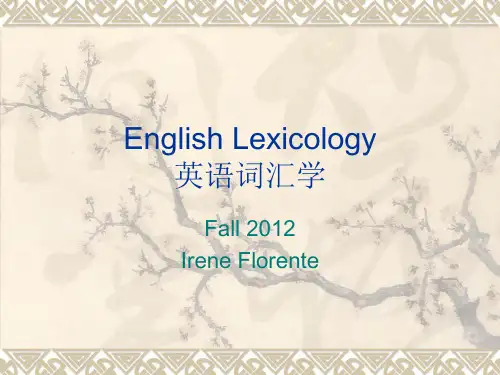
English Lexicology 英语词汇学Fall 2012Irene FlorenteHow do we communicate?Making soundsGesturesWritingWordsAnything else?Write down 10 English words you like on a piece of paperDo you know where these words came from (what languages)?Can they be spelled differently?What part of speech are they? (Noun, verb, adverb, etc)Do these words have more than one meaning or have different meanings when used in idioms?Where do words come from?How are they created?How do they change as history changes?How do they change as people speaking other languages invade or immigrate to their countries?What are the different types of words?Is language alive?(these questions are just for discussion and reflection)Some new words you will learn in this class morphemes, affix, polysemy, vocabulary, characteristics of words, collocations, neologisms, archaisms, characteristics of native words, types of borrowed wordsWhat does lexicology mean?What words do you see in the word?Lexicon/Lexis-ologyAnyone want to take a guess?1. What is lexicology (词汇学)?The literal meaningof lexicology is the “science of the word” It is a branch of linguistics dealing with the vocabulary of a given language. Why is it important to study lexicology? lexicologyLexis/lexicalology (Greek for“of words”) (science of)Topics to be discussed this semesterWhat is a word? How are words created?Where do English words come from?How do languages acquire vocabulary?Different types of vocabulary and word meaningChanges in word structure and word meaning Sense relationsEnglish IdiomsEmail to find class ppts, textbookand notesLogin: lexlinglot@Password: 800morphemesLogin: lexlinglot@Password: 800morphemesSo there’s no need to come and copy the ppts at the end of each class since it will be late when class ends. ☺(the class textbook is already there)What’s in a word?A minimal free form of a languageA sound unityA unit of meaningA form that can function alone in a sentence The term word refers to the fundamental unitof a given language, with sound and meaning (lexical and grammatical), capable of performing a given syntactic function.What’s in a word?Sound and Meaning: A word is a symbol that stands for something else in the world. represents a concept which can be communicated with meaning.A word consists of one or more morphemes Each culture has come to agree that a certain sound represents a certain meaning and there is no “logical relationship”How to say “dog” in differentlanguagesArabic = calbChinese = gouDanish = hundFrench = chienGreek = skylosItalian = caneJapanese = InuSpanish = perroMy point is that these sounds have no logical relation to the actual animal and yet they are all words that mean “dog!”But Chinese characters aredifferent!VocabularyThe term vocabulary refers to all the words of a given languageAll the words in a language make up what is generally known as its vocabularyReviewWhat is a root word?What is a prefix?What is a suffix?These are all examples of affixes.Example of a root word with affixesAffix:A word element, such as a prefix or suffix, that can only occur attached to a base, stem, or root.Root word: “foot”What are some words we can make with “foot?”“Foot” with affixes: Football, footpath, footprint, footageRoot word: “dog”What are some words we can make with “dog?”“Dog” with affixes: doghole, doghouse, dogpaddle, doglikeHow many English words can you make with the letters below? Ekamon (You don’t have to use all letters)MONK MAKE AMOK KENONAME OMEN MANE AMENMOAN MEAN NOM MANMEN AEON EM OM MA MEAM ONE EONON NO ANWhat is a morpheme(形态素,词素)?Definition:A morpheme is the smallest meaningful unit in the grammar of a language.It is the smallest part of a word that still contains meaning.(a morpheme is not the same as a syllable)UnladylikeHow many morphemes are in the word, unladylike?The word un ladyl ike consists of three morphemes and four syllables.Morpheme breaks:un- 'not'lady '(well behaved) female adult human'-like 'having the characteristics of'None of these morphemes can be broken up any more without losing all sense of meaning.Lady cannot be broken up into "la" and "dy," even though "la" and "dy"are separate syllables. Note that each syllable has no meaning on its own.We will learn more about morphemes in Chapter 3.Classification of Morphemes Morphemes can be classified in various ways.Free (word)or bound (cannot be a word by itself)root (basic meaning of word) or affix (prefix or suffix added to root word) Inflectional(word meaning stays the same when affix is added to word) orderivational (word meaning changes when affix is added to word)Example: the words footprint and doghouse are examples of “free”morphemes.Why?They can stand alone as two different words that contains meaning. Don’t worry, we will talk more about these in Chapter 3. ☺Morpheme classification (just for reference)Organizing wordsIf you had to remember a list of 100 words, how would you memorize them?If you had to create a dictionary for these 100 words, how would you organize your dictionary? How would you order the words? What would you write for each word?How are words classified?How often are they used? Or not at all? Are they native or foreign?Are they modern or archaic?Are they simple or complicated?What do they denote or represent?What is the usage of these words?Do these words have meaning or just function words?4 groups of word classification 1.The basic word stock (存货) and non basicvocabulary by use frequency2.Content words and functional words by notion3.Native words and borrowed words by notion4.Simple words, (compounds (复合字) and derived(vt. 得自vi. 起源 ) words by morphology*(I will discuss content, function and borrowedwords in more detail towards the end of the ppt)Basic Word StockWords of the basic word stock denote the most common things and phenomena of the world around us.Natural phenomena: rain, snow, fire, water, sun, moon, spring, wind, hillHuman body and relations: hand, head, mother Names of plants and animals: oak, chicken, dog Numerals, pronouns, prepositions, conjunctions: one, you, but, till, whoPolysemy (意义的分岐 )Polysemy: words belonging to the basic word stock often possess plurality of meaningsReason: because most of them have undergonetransformations in semantic structure in the course ofuse and become polysemousPoly = a prefix, often meaning more than one or many (eg, polyvalent - capable of many valences) Semy (archaic word) = changes in meaningWhat is the meaning of the word “trip”in this sentence #1?1. She took a trip to Florida.A. Be careful, or you will trip!B. We planned our trip together.C. Don’t trip, Man! Its no big deal!2. I turned on the light so I could see better.A. The feather was very light.B. She wore light colors because it was going to be a hot day.C. There is only one light in the living room.What is the meaning of the word“light” in this sentence #2?Do you know what these American slang words mean? They allmean veryinteresting,very great!CollocationsWhat does the word “colloquial” mean?Is it easy to understand the local slang or vocabulary of different cities or even countries?Why does slang exist? Where do they come from? How do they develop?Do people in certain professions have their own specialized vocabulary that are related to their field or study, such as medicine or technology?Collocation:Collocation (n. 排列,安排,布置) This is when basic words become set expressions, idioms or proverbsare usually only understood among people of a common workplace, field of study, residence, location, culture, etc. (Colloquialism)A lot of these expressions, idioms, proverbs and slang cannot be defined literally word by word and must therefore be learned/memorized as a whole expression or idiom.They are often difficult for non-native speakers of that language to understand.The next slides are examples of collocations.Types of collocationsTerminology-technical terms used in particular disciplines and academic areasJargon (n. 专门术语,行话,梦话,土语 ) –specialized vocabulary by which members of the particular arts, sciences, trades and professions communicate among themselvesTypes of collocations Continued Slang- informal words related to a particular segment of a population or informal use of an actual wordFor example, “dough” is what you use to make bread but it is also a slang word for “money”Argot (n. 隐语,暗语,暗号): This is the combined cant (a characteristic or secret language used only by members ofa group, often used to conceal the meaning from thoseoutside the group.) and jargon of criminalsDialectal words – the same word in the same language spoken with phonetic and pronunciation differences inrelation to the speakers of a certain region and/or country.Archaisms and NeologismsArchaisms (n. 古语,古体,拟古主义)– Words or forms that were once in use but are now restricted only to specialized of limited use. Mainly found today in older poems, legal documents and religious writing or speech. Such as thou, thee, wilt. Shakespeare used a lot of archaic words!Neologisms (n. 新语,使用新语,创造新语) –Newly-created words or expressions or words that takeon new meanings. Such as Aids, internetContent WordsContent words denote clear notions (n. 概念,观念,主张,打算,想法)and thus are known as notional words. Notions are a mental image or representation; an idea or conception, a belief or opinion.They are nouns, verbs, adjectives, adverbs and numerals, which denote notions of objects, phenomena, action, quality, state, degree, quantity, slowly etc.Examples: run, people, books, never, eightContent words constitutes the main body of the English vocabularyFunction WordsFunctional words do not have notions (n. 概念,观念,主张,打算,想法)of their own. They are often called empty words.Their chief function is to express the relation between notions, the relation between words as well as betweensentences, they are known as form words.Prepositions (upon, on), conjunctions (connects a sentence: but, and or, yet, so), auxiliary verbs (be, do, have, am) and articles (the, a) belong to this category.Native wordsNeutral in style– they are used by all people, in all places, on all occasions and at all times, Therefore not stylistically specific.Frequent in use-native ones are most frequently use in everyday speech and writing.Borrowed WordsWords taken over from foreign languages are known as borrowed words, loan words or borrowings.English is a heavy borrower and has adopted words from all other major languages of the word.It is estimated that English borrowings constitutes 80% of the modern English vocabulary.There are 4 types of borrowed words.Types of borrowed wordsDenizens– words borrowed early in the past and now are well assimilated into the English language.Examples, port from the latin Portus, pork from the French porc and so on. (n. 居民,外籍居民,外来语vt. 给...居住权,移植)Types of borrowed wordsAliens– borrowed words which have retained their original pronunciation and spelling. They are immediately recognizable as foreign in origin.Examples are: kowtow (Chinese), bazaar (Persian), Kimono (Japanese) and mosquito Spanish)Types of borrowed wordsTranslation loans– are words and expressions formed from the existing material in the English language but modeled on the patterns taken from another language.Example: mother tongue directly translated from the Latin lingua materna, ketchup from the Chinese Dialect “fanqiejiang”Types of borrowed wordsSemantic Loans: Words of this category are not borrowed with reference to the form but to the meaning. In other words, English has borrowed a new meaning for an existing word in the language.Example: The word “dream” originally meant “joy” and “ music” but its modern meaning was taken from the Norse.Chinese words borrowed from otherlanguages 中文外来词拜拜 bye-bye、可口可乐 Coca-cola、咖啡coffee、巧克力 chocolate、汉堡包hamburger、巴士 bus 、卡通 cartoon、台风typhoon、黑客 hacker、因特网 Internet.高尔夫 golf/?p=1259Do you know which Englishwords come from Arabic?bedouin, emir, jakir, gazelle, giraffe, harem, hashish, lute, minaret, mosque, myrrh, salaam, sirocco, sultan, vizier, bazaar, caravanWords from European languages V. Modern English (1650-present)Borrowed words from FrenchFrench continues to be the largest single source of new words outside of very specialized vocabulary domains (scientific/technical vocabulary, still dominated by classical borrowings).High culture —ballet, bouillabaise, cabernet, cachet, chaise longue, champagne, chic, cognac, corsage, faux pas, nom de plume, quiche, rouge, roulet, sachet, salon, saloon, sang froid, savoir faireWar and Military —bastion, brigade, battalion, cavalry, grenade, infantry, pallisade, rebuff, bayonetOther—bigot, chassis, clique, denim, garage, grotesque, jean(s), niche, shockFrench Canadian—chowderLouisiana French (Cajun)—jambalayaBorrowed words from Spanish andItalianSpanisharmada, adobe, alligator, alpaca, armadillo, barricade, bravado, cannibal, canyon, coyote, desperado, embargo, enchilada, guitar,marijuana, mesa, mosquito, mustang, ranch, taco, tornado, tortilla,vigilanteItalianalto, arsenal, balcony, broccoli, cameo, casino, cupola, duo, fresco, fugue, gazette (via French), ghetto, gondola, grotto, macaroni, madrigal, motto, piano, opera, pantaloons, prima donna, regatta, sequin, soprano, opera, stanza, stucco, studio, tempo, torso, umbrella, viola, violinfrom Italian American immigrants—cappuccino, espresso, linguini, mafioso, pasta, pizza, ravioli, spaghetti, spumante, zabaglione,zucchiniBorrowed words from Dutch andGermanDutch, FlemishShipping, naval terms—avast, boom, bow, bowsprit, buoy, commodore, cruise, dock, freight, keel, keelhaul, leak, pump, reef, scoop, scour, skipper, sloop, smuggle, splice, tackle, yawl, yachtCloth industry—bale, cambric, duck (fabric), fuller's earth, mart, nap (of cloth), selvage, spool, stripeArt—easel, etching, landscape, sketchWar—beleaguer, holster, freebooter, furlough, onslaughtFood and drink—booze, brandy(wine), coleslaw, cookie, cranberry, crullers, gin, hops, stockfish, waffleOther—bugger (orig. French), crap, curl, dollar, scum, split (orig. nautical term), uproar Germanbum, dunk, feldspar, quartz, hex, lager, knackwurst, liverwurst, loafer, noodle, poodle, dachshund, pretzel, pinochle, pumpernickel, sauerkraut, schnitzel, zwieback, (beer)stein, lederhosen, dirndl20th century German loanwords—blitzkrieg, zeppelin, strafe, U-boat, delicatessen, hamburger, frankfurter, wiener, hausfrau, kindergarten, Oktoberfest, schuss, wunderkind, bundt (cake), spritz (cookies), (apple) strudelBorrowed words from Yiddish, Scandinavianlanguages and RussianYiddish (most are 20th century borrowings – traditional language spoken mainly among Jewish people)bagel, Chanukkah (Hanukkah), chutzpah, dreidel, kibbitzer, kosher, lox, pastrami (orig. from Romanian), schlep, spiel, schlepp, schlemiel, schlimazel, gefilte fish, goy, klutz, knish, matzoh, oy vey, schmuck, schnook,Scandinavian languagesfjord, maelstrom, ombudsman, ski, slalom, smorgasbordRussianapparatchik, borscht, czar/tsar, glasnost, icon, perestroika, vodka。
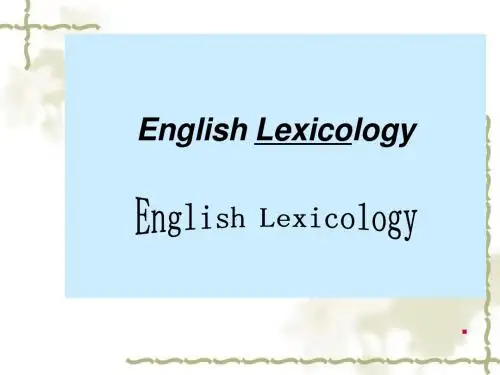
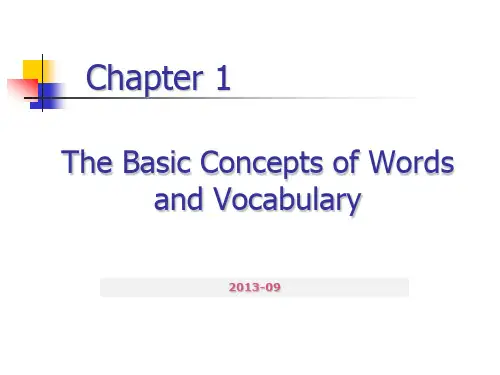
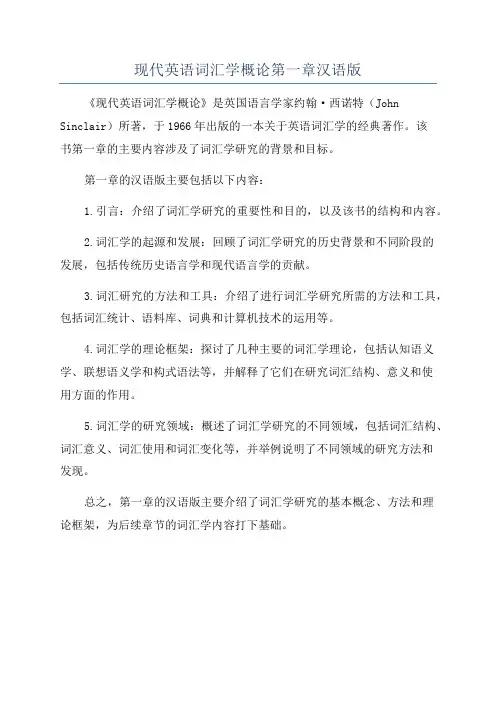
现代英语词汇学概论第一章汉语版
《现代英语词汇学概论》是英国语言学家约翰·西诺特(John Sinclair)所著,于1966年出版的一本关于英语词汇学的经典著作。
该
书第一章的主要内容涉及了词汇学研究的背景和目标。
第一章的汉语版主要包括以下内容:
1.引言:介绍了词汇学研究的重要性和目的,以及该书的结构和内容。
2.词汇学的起源和发展:回顾了词汇学研究的历史背景和不同阶段的
发展,包括传统历史语言学和现代语言学的贡献。
3.词汇研究的方法和工具:介绍了进行词汇学研究所需的方法和工具,包括词汇统计、语料库、词典和计算机技术的运用等。
4.词汇学的理论框架:探讨了几种主要的词汇学理论,包括认知语义学、联想语义学和构式语法等,并解释了它们在研究词汇结构、意义和使
用方面的作用。
5.词汇学的研究领域:概述了词汇学研究的不同领域,包括词汇结构、词汇意义、词汇使用和词汇变化等,并举例说明了不同领域的研究方法和
发现。
总之,第一章的汉语版主要介绍了词汇学研究的基本概念、方法和理
论框架,为后续章节的词汇学内容打下基础。
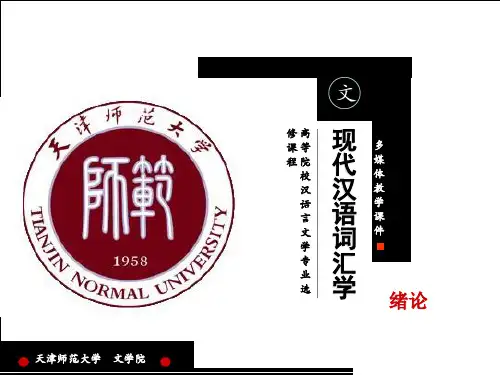

现代英语词汇学单词听写资料Chapter 11. bishop ['biʃəp] n. 主教2. creed [kri:d] n. 信条,教义3. font [fɔnt] n. 洗礼盘,圣水器4. monk [mʌŋk] n. 僧侣,修道士;和尚5. priest [pri:st] n. 牧师;神父;教士6. pardon ['pɑ:dn] n. 原谅;赦免;宽恕7. conquer ['kɔŋkə] vt. 战胜,征服;攻克,攻取8. archer ['ɑ:tʃə] n.弓箭手9. repent [ri'pent] vi.忏悔10. ransom ['rænsəm] vt. 赎回,赎11. baron ['bærən] n. 男爵12. mantle ['mæntl] n. 斗篷13. vestment ['vestmənt] n. (作礼拜时教士的)法衣;官服14. feast [fi:st] n. 筵席,宴会15. sauce [sɔ:s] n.沙司;调味汁16. rhapsody ['ræpsədi] n. [音]狂想曲;狂诗17. tonic ['tɔnik] n. 主调音或基音18. dogma ['dɔɡmə] n. 教条,教理19. trophy ['trəufi] n. 奖品;战利品;纪念品20. attic ['ætik] n. 阁楼;顶楼21. sonnet ['sɔnit] n. 十四行诗22. vista ['vistə] n. 远景,展望23. soprano [sə'prɑ:nəu, -'præ-] n. [音]女高音24. quartet [kwɔ:'tet] n. 四重奏25. dock [dɔk] n. 码头;船坞;26. carouse [kə'rauz] vi. 畅饮;欢宴27. plunder ['plʌndə] n. 战利品;掠夺品28. cobra ['kəubrə] n. 眼镜蛇29. booze [bu:z] n. 酒;酒宴vi. 豪饮;痛饮30. tackle ['tækl] n. 滑车;装备;用具31. roc [rɔk] n. 大鹏,巨鸟32. dingo ['diŋɡəu] n. 澳洲野狗33. sampan ['sæmpæn] n. 舢板;小船34. ketchup ['ketʃəp] n. 蕃茄酱35. yoghourt ['jɔɡət, 'jəu-] n. 酸奶36. safari [sə'fɑ:ri, -'fæ-] n. 旅行;狩猎远征37. tycoon [tai'ku:n] n. 太君38. judo ['dʒu:dəu] n. (日)柔道39. sushi ['su:ʃi] n. 寿司(生鱼片冷饭团)40. favela [fæ'velə] n. 贫民区41. autopista [,ɔːtə(ʊ)'piːstə] n. 高速公路(西班牙语)42. hamam ['hæ'mɑːm] n. 大众浴室,公共澡堂(伊朗的)43. astronaut ['æstrənɔ:t] n. 宇航员44. cartology [kɑː'tɒlədʒɪ] n. 地图学;海图学;图志学45. cryotron ['kraiətrɔn] n. [电子] 冷子管;[电子] 低温管46. aqualung ['ækwəlʌŋ] n. 水中呼吸器;水肺47. montage [mɔn'tɑ:ʒ] n. 蒙太奇(电影的基本结构手段和叙事方式)48. angst [ɑ:ŋst] n. 焦虑;担心49. denotation [,di:nəu'teiʃən] n.外延50. connotation [,kɔnəu'teiʃən] n. 内涵考试形式:老师读英文单词,学生默写单词及汉语意思。